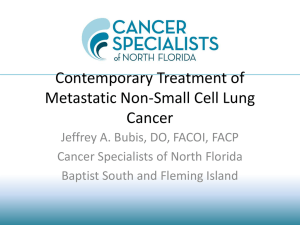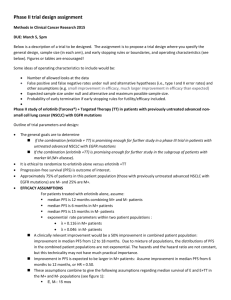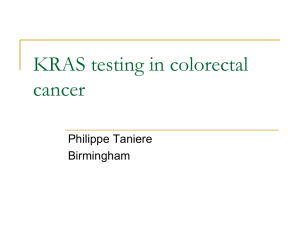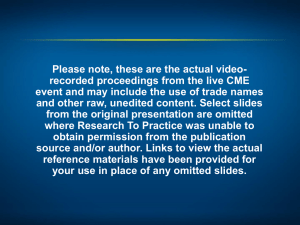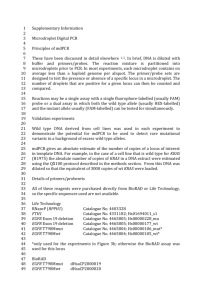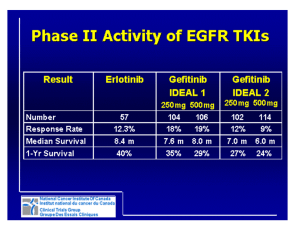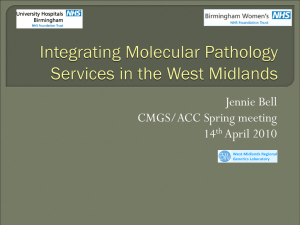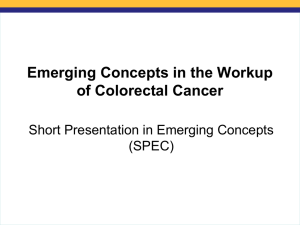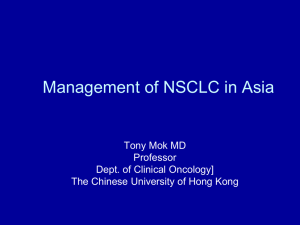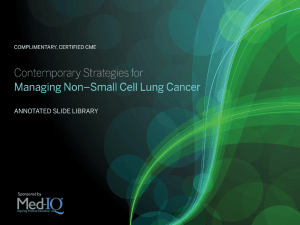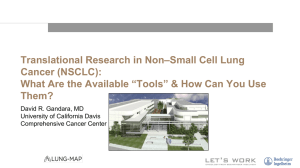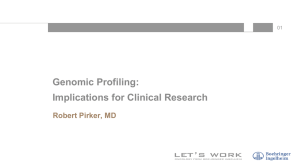Supplemental Appendix Methods: Trial duration and cut
advertisement
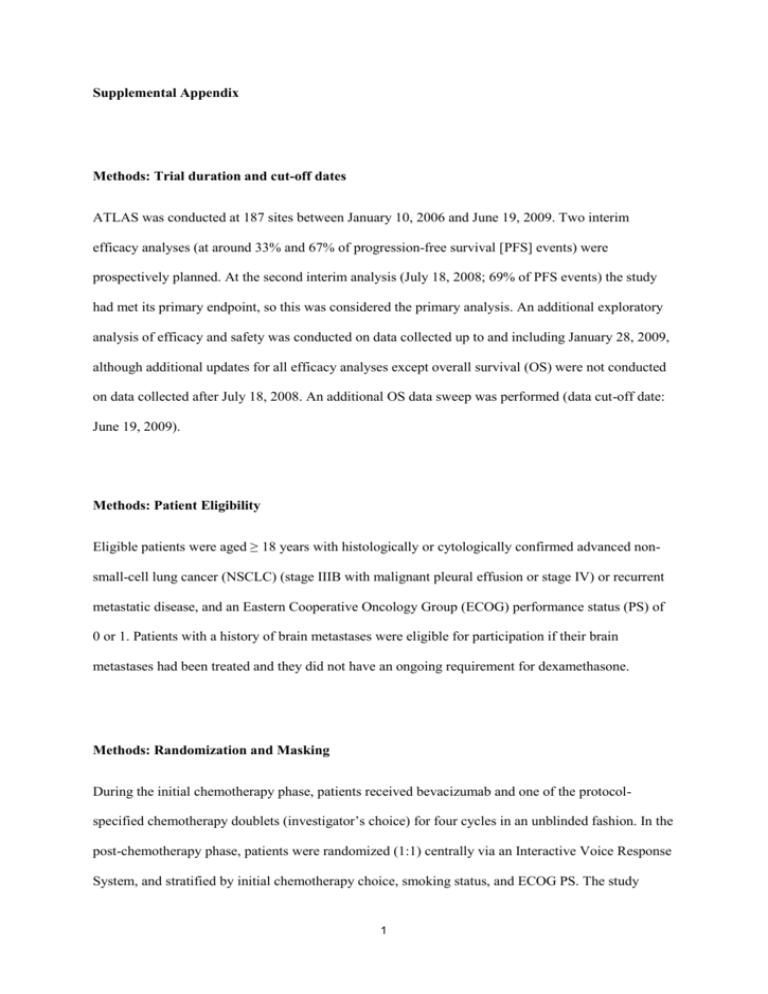
Supplemental Appendix Methods: Trial duration and cut-off dates ATLAS was conducted at 187 sites between January 10, 2006 and June 19, 2009. Two interim efficacy analyses (at around 33% and 67% of progression-free survival [PFS] events) were prospectively planned. At the second interim analysis (July 18, 2008; 69% of PFS events) the study had met its primary endpoint, so this was considered the primary analysis. An additional exploratory analysis of efficacy and safety was conducted on data collected up to and including January 28, 2009, although additional updates for all efficacy analyses except overall survival (OS) were not conducted on data collected after July 18, 2008. An additional OS data sweep was performed (data cut-off date: June 19, 2009). Methods: Patient Eligibility Eligible patients were aged ≥ 18 years with histologically or cytologically confirmed advanced nonsmall-cell lung cancer (NSCLC) (stage IIIB with malignant pleural effusion or stage IV) or recurrent metastatic disease, and an Eastern Cooperative Oncology Group (ECOG) performance status (PS) of 0 or 1. Patients with a history of brain metastases were eligible for participation if their brain metastases had been treated and they did not have an ongoing requirement for dexamethasone. Methods: Randomization and Masking During the initial chemotherapy phase, patients received bevacizumab and one of the protocolspecified chemotherapy doublets (investigator’s choice) for four cycles in an unblinded fashion. In the post-chemotherapy phase, patients were randomized (1:1) centrally via an Interactive Voice Response System, and stratified by initial chemotherapy choice, smoking status, and ECOG PS. The study 1 sponsor, study investigators, and patients were blinded to treatment. Unblinding was allowed at any time for safety reasons, or at disease progression. Methods: A note on the CONSORT diagram A total of 1145 patients were enrolled in the chemotherapy phase (Figure 1) from January 2006 to June 2009. At the July 18, 2008 data cut-off, 743 patients (64.9%) had been randomized into the postchemotherapy phase (intent-to-treat [ITT] population). The collection of samples for biomarker evaluation was optional. At the time of the first data cut-off (July 18, 2008), 177 patients in the bevacizumab plus placebo arm and 190 patients in the bevacizumab plus erlotinib arm were evaluable for biomarker status. As recruitment was not halted until after the Data and Safety Monitoring Board review took place, by the time of the June 19, 2009 data cut-off an additional 25 patients had been randomized; the resulting ITT population comprised 768 patients (67.1%). At the June 19, 2009 data cut-off, 181 patients in the bevacizumab plus placebo arm and 191 patients in the bevacizumab plus erlotinib arm were evaluable for biomarker status. Methods: Biomarker Collection and Analysis Where tumor content was > 40% of the sample, manual macrodissection was used. Where tumor content was ≤ 40% of the sample, laser capture microdissection was employed (Arcturus PixCell II). Analyses of epidermal growth factor receptor (EGFR) mutations in exons 18–21 and KRAS mutations in exons 2 or 3 were performed using Somatic Mutation Scanning by Surveyor® Endonuclease Digestion and Analysis on WAVE HS (Transgenomics Inc, Omaha, NB).1 Amounts of amplifiable DNA were determined using quantitative polymerase chain reaction. Amplicons that were shown to contain variants by Surveyor® analysis were examined by bi-directional sequencing to confirm and characterize the genetic variation. EGFR gene copy number was measured by fluorescence in-situ hybridization (FISH) using the PathVysion® kit from Abbott-Vysis (Des Plaines, IL). High gene copy 2 number by FISH was defined as high polysomy (≥ 4 gene copies in ≥ 40% of cells) or amplification (gene/chromosome ratio ≥ 2 or ≥ 15 gene copies in ≥ 10% of cells); clusters were not counted.2 EGFR protein expression was measured by immunohistochemistry (IHC) using the PharmDxTM kit from DAKO (Glostrup, Denmark); positive EGFR expression was defined as ≥ 10% of tumor cells staining for EGFR.3 Results: A Note on Baseline Characteristics Baseline characteristics and efficacy results for the biomarker evaluable population (BEP) were similar to those in the overall ITT population. Results: A Note on the Sample Size Almost 50% (367/743) of patients were evaluable for biomarker status, in line with previous biomarker analyses from major clinical trials in NSCLC.4,5 Discussion: NSCLC Guidelines The guidelines recommend that all patients should be tested for EGFR mutation status and the ALK fusion gene as a priority at diagnosis, regardless of clinical characteristics. The authors report limited value in testing for KRAS mutations.6 3 BioLOGUE Group Twelve clinicians and advisors with expertise in biomarkers and statistical analysis pooled the results of the BR.21 and SATURN trials. EGFR mutation status was shown to be predictive for erlotinibtreated PFS, but only prognostic for OS, in this pooled analysis. KRAS mutations in clinical studies In the open-label, phase IV TRUST study (in which patients who had previously failed on chemotherapy/radiotherapy or were unsuitable for these therapies were treated with erlotinib until disease progression or unacceptable toxicity), none of the 17 patients with a KRAS mutation had a tumor response.7 In a retrospective study of patients with EGFR wild-type NSCLC treated with an EGFR tyrosine-kinase inhibitor (TKI) (any line), a PFS of 1.6 months was reported in patients with KRAS mutation-positive NSCLC (n = 18), compared with 3.0 months in KRAS wild-type disease (n = 49; p = 0.04).8 The study authors also noted that the group of patients with KRAS mutationpositive NSCLC had a highly variable response to EGFR TKI treatment (PFS range: 0.7–38.7 months). In a second retrospective study, investigators sequenced tumor specimens from 522 patients with advanced NSCLC treated with EGFR TKIs (in the first-, second-, and third-line settings). This study suggested that KRAS mutations were associated with shorter OS (HR: 1.7; 95% CI: 1.1–2·4; p = 0.04].9 References 1. Jänne PA, Borras AM, Kuang Y, et al. A rapid and sensitive enzymatic method for epidermal growth factor receptor mutation screening. Clin Cancer Res 2006;12:751–758. 2. Varella-Garcia M, Diebold J, Eberhard DA, et al. EGFR fluorescence in situ hybridisation assay: guidelines for application to non-small-cell lung cancer. J Clin Pathol 2009;62:970–977. 4 3. Cappuzzo F, Ciuleanu T, Stelmakh L, et al. Erlotinib as maintenance treatment in advanced nonsmall-cell lung cancer: a multicentre, randomised, placebo-controlled phase 3 study. Lancet Oncol 2010;11:521–529. 4. Eberhard DA, Johnson BE, Amler LC, et al. Mutations in the epidermal growth factor receptor and in KRAS are predictive and prognostic indicators in patients with non-small-cell lung cancer treated with chemotherapy alone and in combination with erlotinib. J Clin Oncol 2005;23:5900– 5909. 5. Mok TS, Wu YL, Thongprasert S, et al. Gefitinib or carboplatin-paclitaxel in pulmonary adenocarcinoma. N Engl J Med 2009;361:947–957. 6. Lindeman NI, Cagle PT, Beasley MB, et al. Molecular testing guideline for selection of lung cancer patients for EGFR and ALK tyrosine kinase inhibitors: guideline from the College of American Pathologists, International Association for the Study of Lung Cancer, and Association for Molecular Pathology. J Thorac Oncol 2013;8;823–859. 7. Schneider CP, Heigener D, Schott-von-Romer K, et al. Epidermal growth factor receptor-related tumour markers and clinical outcomes with erlotinib in non-small cell lung cancer: an analysis of patients from German centers in the TRUST study. J Thorac Oncol 2008;3:1446–1453. 8. Metro G, Chiari R, Duranti S, et al. Impact of specific mutant KRAS on clinical outcome of EGFR-TKI-treated advanced non-small cell lung cancer patients with an EGFR wild type genotype. Lung Cancer 2012;78:81–86. 9. Cadranel J, Mauguen A, Faller M, et al. Impact of systematic EGFR and KRAS mutation evaluation on progression-free survival and overall survival in patients with advanced non-smallcell lung cancer treated by erlotinib in a French prospective cohort (ERMETIC project – part 2). J Thorac Oncol 2012;7:1490–1502. 5
